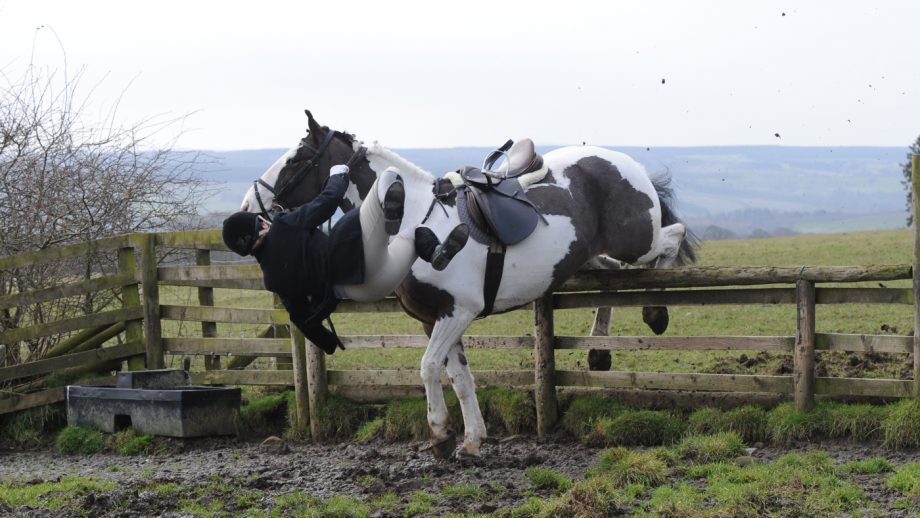While riding hats that comply to accepted standards are already rigorously tested, with some manufacturers going above and beyond the required standards to ensure their products give the best protection possible, new research has suggested ‘there is an urgent need to assess the protective capacity of equestrian helmets under real-world conditions’. H&H finds out more...
There is an “urgent need” to assess the protective capacity of equestrian helmets under more types of real-world conditions, a study involving racing and eventing falls has found.
The study involved researchers from the University College Dublin and the University of Ottawa, as well as British Eventing’s (BE) national safety officer Jonathan Clissold, the British Horseracing Authority’s chief medical officer Jerry Hill and the Irish Horseracing Regulatory Board’s former senior medical officer Adrian McGoldrick.
It was published in the peer-reviewed Journal of Science and Medicine in Sport in March 2020.
{"content":"PHA+VGhlIHB1cnBvc2Ugd2FzIHRvIGV4YW1pbmUgYmlvbWVjaGFuaWNzIG9mIHJlYWwgZXF1ZXN0cmlhbiBhY2NpZGVudHMgYW5kIGRldmVsb3AgYXNzb2NpYXRlZCB0aHJlc2hvbGRzIGZvciB3aGVuIGNvbmN1c3Npb25zIGhhcHBlbi48L3A+CjxwPldoaWxlIG11Y2ggcHJldmlvdXMgdW5kZXJzdGFuZGluZyBvZiBzcG9ydGluZyBjb25jdXNzaW9ucyBpcyBiYXNlZCBvbiByZXNlYXJjaCBpbiBvdGhlciBzcG9ydHMsIHRoaXMgbG9va2VkIHNwZWNpZmljYWxseSBhdCByaWRlciBmYWxscyBhbmQgYWxzbyB0aGUgc3VyZmFjZXMgY29tcGV0aXRvcnMgYXJlIGxpa2VseSB0byBmYWxsIG9uIOKAlCB0dXJmIGFuZCBzYW5kIOKAlCBhbmQgdGhlIGZvcmNlcywgc3BlZWRzIGFuZCBhbmdsZXMgYXNzb2NpYXRlZCB3aXRoIGZhbGxpbmcgZnJvbSBhIGhvcnNlLjwvcD4KPHA+PGRpdiBjbGFzcz0iYWQtY29udGFpbmVyIGFkLWNvbnRhaW5lci0tbW9iaWxlIj48ZGl2IGlkPSJwb3N0LWlubGluZS0yIiBjbGFzcz0iaXBjLWFkdmVydCI+PC9kaXY+PC9kaXY+PHNlY3Rpb24gaWQ9ImVtYmVkX2NvZGUtMzEiIGNsYXNzPSJoaWRkZW4tbWQgaGlkZGVuLWxnIHMtY29udGFpbmVyIHN0aWNreS1hbmNob3IgaGlkZS13aWRnZXQtdGl0bGUgd2lkZ2V0X2VtYmVkX2NvZGUgcHJlbWl1bV9pbmxpbmVfMiI+PHNlY3Rpb24gY2xhc3M9InMtY29udGFpbmVyIGxpc3RpbmctLXNpbmdsZSBsaXN0aW5nLS1zaW5nbGUtc2hhcmV0aHJvdWdoIGltYWdlLWFzcGVjdC1sYW5kc2NhcGUgZGVmYXVsdCBzaGFyZXRocm91Z2gtYWQgc2hhcmV0aHJvdWdoLWFkLWhpZGRlbiI+DQogIDxkaXYgY2xhc3M9InMtY29udGFpbmVyX19pbm5lciI+DQogICAgPHVsPg0KICAgICAgPGxpIGlkPSJuYXRpdmUtY29udGVudC1tb2JpbGUiIGNsYXNzPSJsaXN0aW5nLWl0ZW0iPg0KICAgICAgPC9saT4NCiAgICA8L3VsPg0KICA8L2Rpdj4NCjwvc2VjdGlvbj48L3NlY3Rpb24+PC9wPgo8cD5SaWRpbmcgaGF0cyBmcm9tIHJlcHV0YWJsZSBicmFuZHMgdGhhdCBjb21wbHkgdG8gYWNjZXB0ZWQgc3RhbmRhcmRzIGFyZSBhbHJlYWR5IHJpZ29yb3VzbHkgdGVzdGVkIGluIHJlY3JlYXRlZCBzY2VuYXJpb3MgaW4gd2hpY2ggcmlkZXJzIG1pZ2h0IGZpbmQgdGhlbXNlbHZlcy4gVGhlc2UgY2FuIHZhcnkgc2xpZ2h0bHkgZGVwZW5kaW5nIG9uIHdoaWNoIHN0YW5kYXJkIHRoZXkgY29tcGx5IHdpdGgsIGJ1dCBpbmNsdWRlIHNpdHVhdGlvbnMgc3VjaCBhcyBhIGJsb3cgZnJvbSBhIGhvcnNl4oCZcyBmb290LCB0aGUgY3J1c2hpbmcgZm9yY2UgZnJvbSBhIGZhbGxpbmcgaG9yc2UgYW5kIGxhbmRpbmcgb24gZGlmZmVyZW50IHR5cGVzIG9mIG9iamVjdCwgc3VjaCBhcyBhIHBvbGUuPC9wPgo8cD5NYW55IG1hbnVmYWN0dXJlcnMgYWxzbyBnbyBhYm92ZSBhbmQgYmV5b25kIHRoZSByZXF1aXJlZCB0ZXN0aW5nIHN0YW5kYXJkcyB0byBlbnN1cmUgdGhlaXIgcHJvZHVjdHMgYXJlIGdpdmluZyB0aGUgYmVzdCBwcm90ZWN0aW9uIHBvc3NpYmxlLjwvcD4KPHA+VGhpcyBzdHVkeSBpcyBpbiBubyB3YXkgc2F5aW5nIGhlbG1ldHMgYXJlIG5vdCBmaXQgZm9yIHB1cnBvc2UsIHJhdGhlciB0aGF0IGFzIGtub3dsZWRnZSBvZiB0aGlzIGFyZWEgY29udGludWVzIHRvIGdyb3cgdGhyb3VnaCByZXNlYXJjaCBhbmQgdGVzdGluZywgYXNzZXNzaW5nIHRoZSBsZXZlbCBvZiBwcm90ZWN0aW9uIGhlbG1ldHMgb2ZmZXIgaW4gcmVhbC13b3JsZCBzaXR1YXRpb25zIHdvdWxkIGJlIG9mIGFkZGl0aW9uYWwgYmVuZWZpdC48L3A+CjxkaXYgY2xhc3M9ImFkLWNvbnRhaW5lciBhZC1jb250YWluZXItLW1vYmlsZSI+PGRpdiBpZD0icG9zdC1pbmxpbmUtMyIgY2xhc3M9ImlwYy1hZHZlcnQiPjwvZGl2PjwvZGl2Pgo8cD7igJxUaGlzIGludmVzdGlnYXRpb24gZm91bmQgdGhhdCBjb25jdXNzaXZlIGVxdWVzdHJpYW4gYWNjaWRlbnRzIG9jY3VycmVkIGZyb20gb2JsaXF1ZSBpbXBhY3RzIHRvIHR1cmYgb3Igc2FuZCB3aXRoIGxvd2VyIG1hZ25pdHVkZSBhbmQgbG9uZ2VyIGR1cmF0aW9uIGltcGFjdHMgW3RoYW4gbGluZWFyIGRyb3AgdG8gYSBzdGVlbCBhbnZpbCB0ZXN0aW5nLCBjb21tb25seSB1c2VkIGluIGhlbG1ldCB0ZXN0aW5nIHN0YW5kYXJkc10s4oCdIHN0YXRlcyB0aGUgc3R1ZHkuPC9wPgo8cD7igJxUaGlzIHN1Z2dlc3RzIHRoYXQgY3VycmVudCBlcXVlc3RyaWFuIGhlbG1ldCBzdGFuZGFyZHMgbWF5IG5vdCBhZGVxdWF0ZWx5IHJlcHJlc2VudCByZWFsLXdvcmxkIGNvbmN1c3NpdmUgaW1wYWN0IGNvbmRpdGlvbnMgYW5kLCBjb25zZXF1ZW50bHksIHRoZXJlIGlzIGFuIHVyZ2VudCBuZWVkIHRvIGFzc2VzcyB0aGUgcHJvdGVjdGl2ZSBjYXBhY2l0eSBvZiBlcXVlc3RyaWFuIGhlbG1ldHMgdW5kZXIgcmVhbC13b3JsZCBjb25kaXRpb25zLuKAnTwvcD4KPGRpdiBjbGFzcz0iYWQtY29udGFpbmVyIGFkLWNvbnRhaW5lci0tbW9iaWxlIj48ZGl2IGlkPSJwb3N0LWlubGluZS00IiBjbGFzcz0iaXBjLWFkdmVydCI+PC9kaXY+PC9kaXY+CjxwPkZvb3RhZ2Ugb2YgMSwxMTkgcmFjaW5nIGFuZCBjcm9zcy1jb3VudHJ5IGZhbGxzIGluIEJyaXRhaW4gYW5kIElyZWxhbmQgYmV0d2VlbiBBdWd1c3QgMjAxMSBhbmQgTWF5IDIwMTggd2FzIGNvbGxlY3RlZC4gVGhlc2UgaW5jbHVkZWQgYm90aCBmYWxscyB0aGF0IHJlc3VsdGVkIGluIGRpYWdub3NlZCBjb25jdXNzaW9ucyBhbmQgdGhvc2Ugd2hlcmUgcmlkZXJzIGRpZCBub3QgaGF2ZSBhIGhlYWQgaW5qdXJ5LjwvcD4KPHA+T2YgdGhlc2UgKzEsMTAwIGZhbGxzLCAxMTQgd2VyZSBjb25jdXNzaXZlIGFuZCBvZiB0aGVzZSwgMjUgbWV0IHRoZSBleGFjdCBjcml0ZXJpYSBuZWVkZWQgZm9yIHRoZSBzdHVkeS4gVGhpcyBpbmNsdWRlZCBoYXZpbmcgYSBjbGVhciB2aWV3IG9mIHRoZSBmYWxsLCB0aGUgcmlkZXLigJlzIGhlYWQgbXVzdCBoYXZlIGhpdCB0aGUgZ3JvdW5kIGFuZCB0aGV5IGNhbm5vdCBoYXZlIGhhZCBtdWx0aXBsZSBpbXBhY3RzIChmb3IgZXhhbXBsZSwgZmFsbHMgd2hlcmUgYSByaWRlciBsYW5kZWQgYW5kIHRoZW4gd2FzIGtpY2tlZCB3ZXJlIGV4Y2x1ZGVkKS4gVGhlIHN0dWR5IGFsc28gaW5jbHVkZWQgMjUgbm9uLWNvbmN1c3NpdmUgZmFsbHMuPC9wPgo8ZGl2IGNsYXNzPSJhZC1jb250YWluZXIgYWQtY29udGFpbmVyLS1tb2JpbGUiPjxkaXYgaWQ9InBvc3QtaW5saW5lLTUiIGNsYXNzPSJpcGMtYWR2ZXJ0Ij48L2Rpdj48L2Rpdj4KPHA+VGhlc2UgNTAgZmFsbHMsIHdoaWNoIGluY2x1ZGVkIGJvdGggbWVuIGFuZCB3b21lbiwgd2VyZSB0aGVuIHJlY29uc3RydWN0ZWQuPC9wPgo8cD7igJxGcm9tIHRoZSBhY2NpZGVudCByZWNvbnN0cnVjdGlvbnMsIGl0IGlzIGFwcGFyZW50IHRoYXQgY3VycmVudCBjZXJ0aWZpY2F0aW9uIHN0YW5kYXJkcyBmb3IgZXF1ZXN0cmlhbiBoZWxtZXRzIHJlcHJlc2VudCBkaWZmZXJlbnQgbG9hZGluZyBjb25kaXRpb25zIHRoYW4gdGhvc2UgYXNzb2NpYXRlZCB3aXRoIHJlYWwtd29ybGQgY29uY3Vzc2lvbizigJ0gY29uY2x1ZGVkIHRoZSByZXNlYXJjaGVycy48L3A+CjxwPuKAnEl0IGlzIHVua25vd24gaG93IGVxdWVzdHJpYW4gaGVsbWV0cyBwZXJmb3JtIGZvciBvYmxpcXVlIGltcGFjdHMgdG8gYSBjb21wbGlhbnQgc3VyZmFjZSBhbmQsIHRoZXJlZm9yZSwgdGhlcmUgaXMgYSBuZWVkIHRvIGFzc2VzcyB0aGUgcHJvdGVjdGl2ZSBjYXBhY2l0eSBvZiBlcXVlc3RyaWFuIGhlbG1ldHMgdW5kZXIgdGhlc2UgaW1wYWN0IGxvYWRpbmcgY29uZGl0aW9ucy7igJ08L3A+CjxwPk1yIENsaXNzb2xkIHRvbGQgPGVtPkgmYW1wO0g8L2VtPiBCRSB3YXMg4oCcbHVja3kgZW5vdWdo4oCdIHRvIHdvcmsgd2l0aCBEciBNaWNoaW8gQ2xhcmssIG9uZSBvZiB0aGUgc3R1ZHnigJlzIGF1dGhvcnMsIG9uIHRoaXMg4oCcdmVyeSBkZXRhaWxlZCBhbmQgdGhvcm91Z2ggcHJvamVjdOKAnS48L3A+CjxwPuKAnFdlIGhvcGUgdGhlIGZpbmRpbmdzIHdpbGwgbGVhZCB0byBmdXJ0aGVyIGRldmVsb3BtZW50IG9mIGVxdWVzdHJpYW4gaGVsbWV0cyB0byBoZWxwIHJlZHVjZSB0aGUgcmlzayBvZiByaWRlcnPigJkgYmVpbmcgY29uY3Vzc2VkIGluIGZhbGxzLOKAnSBoZSBhZGRlZC48L3A+CjxwPkEgc3Bva2VzbWFuIGZvciBDaGFybGVzIE93ZW4sIHdoaWNoIHByb3ZpZGVkIGhlbG1ldHMgZm9yIHRoZSByZXNlYXJjaCwgdG9sZCA8ZW0+SCZhbXA7SDwvZW0+IHN0dWRpZXMgbGlrZSB0aGlzIGFyZSDigJxpbXBvcnRhbnQgdG8gc3VwcG9ydCB0aGUgd2hvbGUgZXF1ZXN0cmlhbiBpbmR1c3RyeSBpbiB0YWtpbmcgc21hbGwgc3RlcHMgdG93YXJkcyBpbXByb3ZlZCBzYWZldHkgZm9yIGFsbCByaWRlcnPigJ0uPC9wPgo8cD7igJxUaGUgcmVzZWFyY2ggZnJvbSB0aGlzIHBhcGVyLCBhbmQgb3RoZXJzIGxpa2UgaXQsIGFyZSB1c2VkIGFzIHJlZmVyZW5jZSBtYXRlcmlhbCBmb3IgaW5kdXN0cnktc3RhbmRhcmQgY29tbWl0dGVlcywgbGlrZSBBU1RNIFtBbWVyaWNhbiBTb2NpZXR5IGZvciBUZXN0aW5nIGFuZCBNYXRlcmlhbHMg4oCUIG9uZSBvZiB0aGUgc2FmZXR5IHN0YW5kYXJkcyByaWRpbmcgaGVsbWV0cyBjYW4gY29tcGx5IHRvXSzigJ0gaGUgc2FpZC48L3A+CjxwPuKAnFRob3NlIHN0YW5kYXJkcyBkaWN0YXRlIHRoZSBraW5kIG9mIHRlc3RzIGVhY2ggZXF1ZXN0cmlhbiBoZWxtZXQgbXVzdCBnbyB0aHJvdWdoIHRvIGJlIHNvbGQgaW4gdmFyaW91cyBtYXJrZXRzIGFyb3VuZCB0aGUgd29ybGQuIFNvIGluIGVzc2VuY2UsIHJlc2VhcmNoIHBhcGVycyBhbmQgc3R1ZGllcyBjb25kdWN0ZWQgdG9kYXkgaGVscCBmb3JtIHNhZmV0eSBzdGFuZGFyZHMgZm9yIHJpZGVy4oCZcyBoZWxtZXRzIGZvciB0aGUgZnV0dXJlLuKAnTwvcD4KPHA+VGhlIHNwb2tlc21hbiBhZGRlZCBEciBDbGFyayBoYXMgc3BlbnQgdGltZSBhdCBDaGFybGVzIE93ZW4gYW5kIGhhcyBiZWVuIGludm9sdmVkIGluIG90aGVyIHB1Ymxpc2hlZCBwYXBlcnMg4oCcdml0YWzigJ0gaW4gc2hhcGluZyBlcXVlc3RyaWFuIGhlbG1ldCBzdGFuZGFyZHMuPC9wPgo8cD7igJxXZSBhcmUgYWN0aXZlbHkgdXNpbmcgdGhlbSBpbiB0aGUgaGVsbWV0IGNvbW1pdHRlZXMgYW5kIHdvcmtpbmcgZ3JvdXBzIHRoYXQgYWRkcmVzcyBjaGFuZ2VzIGFuZCBpbXByb3ZlbWVudHMgZm9yIHRoZSBmdXR1cmUs4oCdIGFkZGVkIHRoZSBzcG9rZXNtYW4uPC9wPgo8cD7igJxIYXZpbmcgYSB3aWRlciBhdWRpZW5jZSBpbiB0aGUgZ2VuZXJhbCBwdWJsaWMgcmF0aGVyIHRoYW4ganVzdCBhY2FkZW1pY3MgYW5kIHRoZSBpbmR1c3RyeSB3aWxsIGFsc28gaGVscCB0byBwdXNoIGNoYW5nZXMuPC9wPgo8cD7igJxUaGlzIHBhcGVyIGFuZCBvdGhlcnMgdGhhdCBsb29rIGF0IG9ibGlxdWUgaW1wYWN0cyBhcmUgbWFraW5nIHRoZSBub2lzZSBuZWNlc3NhcnkgZm9yIGNoYW5nZSBhbmQgbmV3IHRlc3QgbWV0aG9kb2xvZ3kgaW4gdGhlIHN0YW5kYXJkcyBpcyBiZWluZyB3cml0dGVuLjwvcD4KPHA+4oCcVGhlIGhlbG1ldCBpbmR1c3RyeSBpcyB0YWtpbmcgbm90aWNlIGFuZCBsb29raW5nIHRvIGNyZWF0ZSBoZWxtZXRzIHRoYXQgbWl0aWdhdGUgcm90YXRpb25hbCBmYWxscy7igJ08L3A+CjxwPkEgc3Bva2VzbWFuIGZvciBoZWxtZXQgbWFudWZhY3R1cmVyIENoYW1waW9uIFNhZmV0eSBhZGRlZCB0aGUgY29tcGFueSBoYXMgYmVlbiBpbnZlc3RpZ2F0aW5nIHRoZSByZWxhdGlvbnNoaXAgYmV0d2VlbiByb3RhdGlvbmFsIGFjY2VsZXJhdGlvbiBhbmQgY29uY3Vzc2lvbiBmb3IgbWFueSB5ZWFycywgcmVjZW50bHkgaW50cm9kdWNpbmcgdGhlIE1JUFMgKG11bHRpLWRpcmVjdGlvbmFsIGltcGFjdCBwcm90ZWN0aW9uIHN5c3RlbSkgYnJhaW4gcHJvdGVjdGlvbiBzeXN0ZW0gdG8gc2V2ZXJhbCByYW5nZXMgb2YgaXRzIGhlbG1ldHMuIFRoZSBNSVBTIHN5c3RlbSBpcyBhbHNvIGF2YWlsYWJsZSBpbiBzb21lIHJpZGluZyBoYXRzIGZyb20gb3RoZXIgbWFudWZhY3R1cmVycy48L3A+CjxwPuKAnE1JUFMgd29ya3MgYnkgYWxsb3dpbmcgYSBzbWFsbCBtb3ZlbWVudCBvZiB0aGUgaGVsbWV0IG9uIHRoZSBoZWFkIHdoaWNoIHJlZGlyZWN0cyByb3RhdGlvbmFsIGZvcmNlcyBhd2F5IGZyb20gdGhlIHNrdWxsIGluIHRoZSBldmVudCBvZiBhIGZhbGwgYW5kIGluIGRvaW5nIHNvIGhlbHBzIG1pdGlnYXRlIGFnYWluc3QgYnJhaW4gaW5qdXJ5LOKAnSBoZSB0b2xkIDxlbT5IJmFtcDtIPC9lbT4uPC9wPgo8ZGl2IGNsYXNzPSJpbmplY3Rpb24iPjwvZGl2Pgo8cD7igJxBcyB0aGUgaW5kdXN0cnnigJlzIHVuZGVyc3RhbmRpbmcgb2YgdGhlIHJlbGF0aW9uc2hpcCBiZXR3ZWVuIGhvcnNlIHJpZGVyIGZhbGxzIGFuZCBjb25jdXNzaW9uIGluY3JlYXNlcywgd2UgaG9wZSB0byBzZWUgbW9yZSB0ZXN0IGxhYnMgaGF2aW5nIHRoZSBjYXBhYmlsaXR5IHRvIG1lYXN1cmUgdGhlc2UgZm9yY2VzIGFuZCB0aGlzIHdpbGwgaG9wZWZ1bGx5IG1lYW4gd2UgY2FuIHN0YXJ0IHRvIGluY2x1ZGUgcGVyZm9ybWFuY2UgY3JpdGVyaWEgZm9yIHRoaXMgdHlwZSBvZiBpbmp1cnkgaW50byBvdXIgZ2xvYmFsIHN0YW5kYXJkcy7igJ08L3A+CjxwPgo="}
You may also be interested in…
Library image.
Credit: TREVOR MEEKS
A safety feature, already widely used in cycling and skiing helmets and designed to reduce brain injuries, could revolutionise riding
An examination of a hat credited by its owner for saving her life showed it had 'done its job exceptionally
British discipline and riding bodies are reconsidering their hat rules for the future and phasing out a popular helmet standard
Stay in touch with all the news in the run-up to and throughout the major shows and events during 2025 and beyond with a Horse & Hound subscription. Subscribe today for all you need to know ahead of these major events, plus online reports on the action as it happens from our expert team of reporters and in-depth analysis in our special commemorative magazines. Have a subscription already? Set up your unlimited website access now
H&H senior news writer
Lucy is an experienced news journalist, reporter and presenter. Since joining the Horse & Hound team in 2015, Lucy has reported from major global sporting events including the Tokyo Paralympic Games and multiple European Championships, as well as Badminton, Burghley and London, to name a few. She has covered current affairs and sports news across the full spectrum of equestrian disciplines and racing, as well as human and equine welfare, industry news and court cases.




